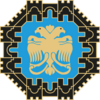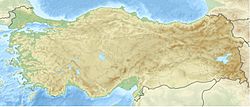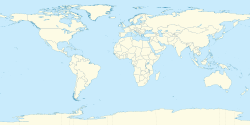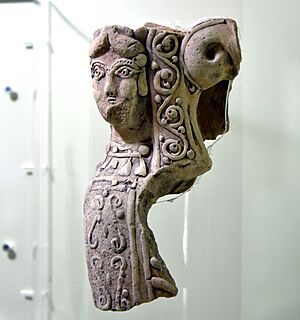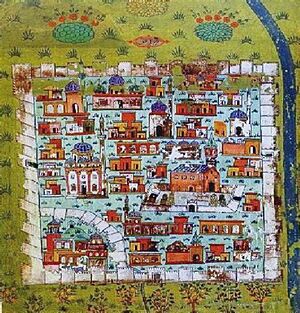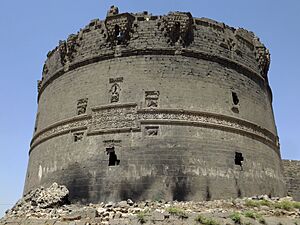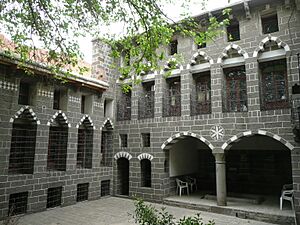Diyarbakır facts for kids
Quick facts for kids
Diyarbakır
|
||
|---|---|---|
|
Big City Municipality
|
||
|
Clockwise from top: A pond park in Diyarbakir, Hasan Pasha Han, historic city walls, Gazi Pavillion, A park in Diyarbakir, Ongözlü Bridge (The Dicle Bridge), Great Mosque of Diyarbakır.
|
||
|
||
| Country | Turkey | |
| Region | Southeastern Anatolia | |
| Province | Diyarbakır | |
| Area | ||
| • Big City Municipality | 15,058 km2 (5,814 sq mi) | |
| • Urban | 2,410 km2 (930 sq mi) | |
| • Metro | 2,410 km2 (930 sq mi) | |
| Elevation | 675 m (2,215 ft) | |
| Population
(2021 estimation)
|
||
| • Big City Municipality | 1,791,373 | |
| • Density | 118.965/km2 (308.118/sq mi) | |
| • Urban | 1,129,218 | |
| • Urban density | 468.6/km2 (1,213.6/sq mi) | |
| • Metro | 1,129,218 | |
| • Metro density | 468.6/km2 (1,213.6/sq mi) | |
| GDP | ||
| • Big City Municipality | TRY 62.494 billion US$ 6.959 billion (2021) |
|
| • Per capita | TRY 34,964 US$ 3,893 (2021) |
|
| Time zone | UTC+3 (TRT) | |
| Postal code |
21x xx
|
|
| Area code(s) | 412 | |
| Licence plate | 21 | |
| Website | www.diyarbakir.gov.tr | |
Diyarbakır (pronounced dee-yar-BAH-kur) is a large city in Turkey. It is known for having a majority of Kurdish people. The city is the main center of the Diyarbakır Province.
Diyarbakır sits on a high plateau next to the Tigris river. The old Diyarbakır Fortress stands proudly there. It is the second-largest city in the Southeastern Anatolia Region of Turkey. In December 2021, about 1.79 million people lived in the wider province. Over 1.1 million lived in the main city area.
This city has been an important place for many years. Some people see it as a key city for Kurdish culture. In 2023, earthquakes in Turkey and Syria caused some damage to its old city walls.
Contents
What's in a Name?
The city has had many names over time. In ancient times, it was called Amida. This name might come from an older word, Amedi. The name Āmid was also used in Arabic.
After Muslim groups took control in the 600s, the city became known as Diyar Bakr. This means "the home of the Bakr tribe." This tribe had settled in the area before. The city was also called Kara-Amid, meaning "Black Amid," because of its black basalt walls.
In 1937, the Turkish President Atatürk changed the city's name to "Diyarbakır." This new name means "land of copper" in Turkish. There is a lot of copper around the city. This change was part of a plan to give Turkish names to places that had non-Turkish names.
Today, the city is called Tigranakert in Armenian. In Kurdish, it is known as Amed. In Syriac, it is called Āmīd.
A Look Back in Time
Ancient History

People have lived in the Diyarbakır area since the Stone Age. The first big civilization here was the Hurrian kingdom of Mitanni. Many different groups then ruled the area. These included the Assyrians, Armenians, and Persians.
The Roman Republic took control of the city in 66 BC. They called it "Amida." In 359 AD, the Persian ruler Shapur II captured Amida after a long fight. Amida became a major city in the Roman province of Mesopotamia. It had an amphitheater, public baths, and water systems.
The Romans and Persians often fought over the area. The city walls were rebuilt by Roman emperors to make them stronger. In 628 AD, the Roman emperor Heraclius took the city back from the Persians. He also built a church there.
Religious History

Christianity became strong in the region between the 1st and 4th centuries AD. The Roman emperor Theodosius II made Amida the capital of Mesopotamia Prima. This meant it was an important religious center for many bishops.
Diyarbakır also became a center for the Armenian Church. Later, some Armenian churches in the city joined the Armenian Catholic Church. There was also a church for the Syriac Catholic Church. During difficult times in the early 1900s, many Christians in the city faced hardship.
Middle Ages
In 639 AD, Diyarbakır was taken by Muslim armies. The Great Mosque of Amida was built in the city center. There were also many Christian churches and monasteries. The Church of the Virgin Mary is still used today.
The city was part of different Islamic empires. It was ruled by the Umayyad Caliphate and then the Abbasid Caliphate. Later, local rulers took over. The Seljuks took the city in 1085, and the Ayyubids in 1183.
In 1260, the Mongols captured the city after a long fight. After the Mongols, two Turkoman groups, the Kara Koyunlu and Aq Qoyunlu, controlled Diyarbakır. The Ottoman Empire finally conquered the city in 1514.
Ottoman and Modern Times
The Ottoman Empire took control of Diyarbakır in 1514. The city became the center of the Diyarbekir Eyalet, a large region. Diyarbakır was an important military base. It was also known for its skilled workers who made glass and metal items.
Over time, the Ottomans tried to control the local Kurdish leaders more closely. This led to some unrest in the region. In the late 1800s, many Armenians and Assyrians in the area faced violence. Around 1900, most Christians in the city were Armenians and Syriac Orthodox Christians.
Republic of Turkey
In 1928, Diyarbakır became a key center for a large region in Turkey. In 1993, it became a Metropolitan Municipality, a type of big city government.
Diyarbakır has seen some difficult times in recent years. In 2015-2016, parts of the Sur district were damaged during fighting. A report in 2018 showed that much of the historic Sur district was destroyed. However, by 2021, many parts of the city were being rebuilt. Officials hoped to bring back tourism.
In 2023, the city was hit by strong earthquakes. Many buildings collapsed or were badly damaged.
Sports and Fun
Diyarbakır has two main football clubs: Diyarbakırspor (started in 1968) and Amed S.F.K. (started in 1990). There is also a women's football team, Amed S.K., which plays in Turkey's top league.
City Life and Culture
Diyarbakır is known for its local jewelry and crafts. Folk dancing with drums and pipes is a big part of weddings and celebrations. The Diyarbakir Municipality Theatre used to perform plays, including some in the Kurdish language.
One important celebration is Nowruz. This holiday marks the start of spring and the new year. It has been celebrated for thousands of years in Asia and the Middle East. In Kurdish areas of Turkey, Nowruz is a very important tradition. People light fires, wear new clothes, dance, and give gifts.
Delicious Food
Diyarbakır's food often includes lamb dishes. They use spices like black pepper, sumac, and coriander. Rice, bulgur, and butter are also common. Local dishes include Meftune, which is lamb and vegetables with garlic and sumac. Kaburga Dolması is baked lamb ribs stuffed with rice and spices. Watermelons are grown nearby, and the city has an annual Watermelon Festival!
Places to See
The old part of Diyarbakır is surrounded by tall, black basalt walls. These walls are about 5.5 kilometers (3.4 miles) long. There are four gates and 82 watchtowers. The walls were first built long ago and made stronger by the Roman emperor Constantius II in 349 AD. The area inside the walls is called the Sur district.
Old Mosques and Schools
- Great Mosque of Diyarbakır: Built in the 1000s by the Seljuk Turkish Sultan Malik Shah. It's one of Turkey's oldest mosques. It uses black basalt and white limestone.
- Behram Pasha Mosque: An Ottoman mosque built in 1572. It has beautiful arches at the entrance.
- Sheikh Matar Mosque with its Four-legged Minaret: Built by Kasim Khan.
- Fatihpaşa Camii: Built in 1520, it is the city's oldest Ottoman building. It has lovely tilework.
- Hazreti Süleyman Mosque: Built between 1155 and 1169. Süleyman, who died capturing the city, is buried here.
- Nebii Camii: A 1500s mosque named "the mosque of the prophet" because of writings on its minaret.
Churches
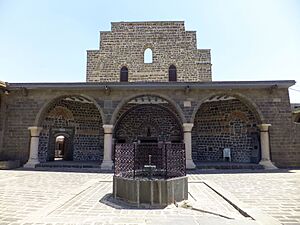
- St. Giragos Armenian Church: First built in 1519, the current building is from 1883. It has been restored and is now used again.
- The Syriac Orthodox Church of Our Lady: First built as a pagan temple in the 1st century BC. The current church is from the 3rd century and is still used today.
- Mar Petyun (St. Anthony) Chaldean Catholic Church: Built in 1681.
Museums
- The Archaeological Museum: Holds old items from different time periods, like the Stone Age, Roman times, and Ottoman times.
- Cahit Sıtkı Tarancı Museum: The home of a famous poet, showing a classic Diyarbakır house.
- Ziya Gökalp Museum: The birthplace of another poet, now a museum about his life.
Other Historic Spots
- The Diyarbakır Fortress and Hevsel Gardens: These are a UNESCO World Heritage site, recognized for their history and beauty.
- Hasan Pasha Han: A large Ottoman inn from the 1500s, now has shops and cafes.
- Delliler Han: An inn built in 1527, now a five-star hotel.
- Dicle Bridge: An 11th-century bridge with ten arches.
- Urfa Kapi (Urfa Gate): One of the four main gates in the city walls. It was built in the 300s.
Weather in Diyarbakır
Diyarbakır has a Mediterranean type of weather. Summers are very hot and dry. This is because of its location on the Mesopotamian plain, which gets hot air from the deserts to the south. The hottest temperature ever recorded was 46.2°C (112.64°F) in July 1937.
Winters are cool with some rain and frosty nights. Snow often falls between December and March. The coldest temperature ever recorded was -24.2°C (-10.12°F) in January 1933. The most snow recorded was 65 cm (25.6 inches) in January 1971.
| Climate data for Diyarbakır (1991–2020, extremes 1929–2023) | |||||||||||||
|---|---|---|---|---|---|---|---|---|---|---|---|---|---|
| Month | Jan | Feb | Mar | Apr | May | Jun | Jul | Aug | Sep | Oct | Nov | Dec | Year |
| Record high °C (°F) | 16.9 (62.4) |
21.8 (71.2) |
28.3 (82.9) |
35.3 (95.5) |
39.8 (103.6) |
42.0 (107.6) |
46.2 (115.2) |
45.9 (114.6) |
42.2 (108.0) |
35.7 (96.3) |
28.4 (83.1) |
22.5 (72.5) |
46.2 (115.2) |
| Mean daily maximum °C (°F) | 7.3 (45.1) |
9.6 (49.3) |
15.0 (59.0) |
20.5 (68.9) |
26.8 (80.2) |
34.4 (93.9) |
38.9 (102.0) |
38.7 (101.7) |
33.4 (92.1) |
25.7 (78.3) |
16.3 (61.3) |
9.2 (48.6) |
23.0 (73.4) |
| Daily mean °C (°F) | 2.1 (35.8) |
3.8 (38.8) |
8.7 (47.7) |
13.5 (56.3) |
18.9 (66.0) |
26.3 (79.3) |
31.0 (87.8) |
30.5 (86.9) |
25.0 (77.0) |
17.8 (64.0) |
9.3 (48.7) |
3.8 (38.8) |
15.9 (60.6) |
| Mean daily minimum °C (°F) | −2.0 (28.4) |
−1.1 (30.0) |
2.6 (36.7) |
6.6 (43.9) |
10.9 (51.6) |
16.8 (62.2) |
21.7 (71.1) |
21.2 (70.2) |
15.9 (60.6) |
10.4 (50.7) |
3.8 (38.8) |
−0.5 (31.1) |
8.9 (48.0) |
| Record low °C (°F) | −24.2 (−11.6) |
−21.0 (−5.8) |
−14.0 (6.8) |
−6.1 (21.0) |
0.8 (33.4) |
1.8 (35.2) |
9.9 (49.8) |
11.4 (52.5) |
4.0 (39.2) |
−1.8 (28.8) |
−12.9 (8.8) |
−23.4 (−10.1) |
−24.2 (−11.6) |
| Average precipitation mm (inches) | 63.6 (2.50) |
66.8 (2.63) |
67.5 (2.66) |
63.1 (2.48) |
50.0 (1.97) |
10.8 (0.43) |
1.0 (0.04) |
0.4 (0.02) |
8.4 (0.33) |
37.3 (1.47) |
54.3 (2.14) |
75.3 (2.96) |
498.5 (19.63) |
| Average precipitation days | 10.93 | 11.27 | 11.13 | 11.6 | 9.47 | 2.9 | 0.4 | 0.23 | 1.37 | 5.83 | 7.43 | 11.33 | 83.9 |
| Average snowy days | 4.5 | 3.2 | 1.1 | 0 | 0 | 0 | 0 | 0 | 0 | 0 | 0.4 | 1.6 | 10.8 |
| Average relative humidity (%) | 76.4 | 71.8 | 66.4 | 65.1 | 57.3 | 34.4 | 25.2 | 24.7 | 30.6 | 47.7 | 64.7 | 76.5 | 53.3 |
| Mean monthly sunshine hours | 124.0 | 135.6 | 173.6 | 210.0 | 282.1 | 348.0 | 362.7 | 341.0 | 279.0 | 220.1 | 165.0 | 114.7 | 2,755.8 |
| Mean daily sunshine hours | 4.0 | 4.8 | 5.6 | 7.0 | 9.1 | 11.6 | 11.7 | 11.0 | 9.3 | 7.1 | 5.5 | 3.7 | 7.5 |
| Source 1: Turkish State Meteorological Service | |||||||||||||
| Source 2: NOAA (humidity, 1991–2020), Meteomanz(snow days 2000-2023) | |||||||||||||
Famous People from Diyarbakır
- Ahmed Arif, a well-known poet.
- Ayşe Şan, a famous Kurdish singer.
- Cahit Sıtkı Tarancı, another important poet.
- Gazi Yaşargil, a medical scientist and brain surgeon.
- Leyla Zana, a politician.
- Osman Baydemir, a Kurdish politician.
- Songül Öden, an actress.
- Ziya Gökalp, a sociologist and writer. Many places in the city are named after him.
- Mıgırdiç Margosyan, a writer.
- Kevork Malikyan, an actor.
Images for kids
See also
 In Spanish: Diyarbakır para niños
In Spanish: Diyarbakır para niños









